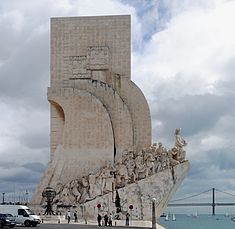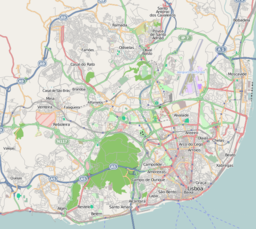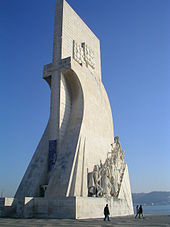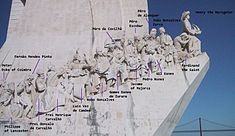- Padrão dos Descobrimentos
-
Monument to the Discoveries (Padrão dos Descobrimentos) Monument (Monumento) The Padrão dos Descobrimentos on the edge of the Tagus River, as seen along its western profileName origin: padrão dos descobrimentos Portuguese for mark of the discoveries Country  Portugal
PortugalRegion Lisbon Sub-region Grande Lisboa District Lisbon Municipality Lisbon Location Santa Maria de Belém - elevation 50 m (164 ft) - coordinates 38°41′36.98″N 9°12′20.59″W / 38.6936056°N 9.2057194°W Length 46 m (151 ft), North-South Width 20 m (66 ft), West-East Height 52 m (171 ft) Depth 20 m (66 ft) Architects Cottinelli Telmo, Leopoldo de Almeida, Cristino da Silva Style Modern classicism Materials Steel, Cement Origin 3 February 1958 - Initiated November 1958 - Inauguration 9 August 1960 - Inauguration 10 October 1960 Owner Portuguese Republic For public Public Visitation Closed (Mondays and on 1 January, Easter Sunday, 1 May and 25 December) Easiest access Avenida de Índia-Avenida de Brasília Management Câmara Municipal of Lisbon Operator Gestão de Equipamentos e Animação Cultural, E.E.M. October–April 10:00 a.m.-6:00 p.m. May–September 10:00 a.m.-7:00 p.m. Wikimedia Commons: Padrão dos Descobrimentos Website: http://www.padraodosdescobrimentos.egeac.pt/ Dimensional detail from SIPA – Sistema de Informação para o Património Arquitectónico (2008); operational information from Gestão de Equipamentos e Animação Cultural, E.E.M. Padrão dos Descobrimentos (Portuguese pronunciation: [pɐˈdɾɐ̃w̃ duʃ dɨʃkubɾiˈmẽtuʃ]; lit. Monument to the Discoveries) is a monument on the northern margin of the Tagus River estuary, in the civil parish of Santa Maria de Belém, Lisbon. Located along the river were ships departed to explore and trade with India and Orient, the monument celebrates the Portuguese Age of Discovery (or Age of Exploration) during the 15th and 16th centuries.
Contents
History
It was conceived in 1939 by Portuguese architect José Ângelo Cottinelli Telmo, and sculptor Leopoldo de Almeida, as a temporary beacon during the Portuguese World Fair opening in June 1940.[1] The Monument to the Discoveries represented a romantized idealization of the Portuguese exploration that was typical of the Estado Novo regime of António de Oliveira Salazar. It was originally constructed as a temporary construction, located in the Praça do Império as part of an urban renewal project favoured by minister Duarte Pacheco, but with the resistance of Cottinelli Telmo.[1] Yet, by June 1943, the original structure was demolished after the Exposition as there was no concrete formalization of the project.[1][2]
On 3 February 1958, in decree No.41-517, the government, through the Ministério de Obras Publicas (Ministry of Public Works), the Overseas Provinces and the Câmara Municipal of Lisbon promote the intent to construct a permanent Monument to the Discoveries.[1] Between November 1958 and January 1960, the new monument was constructed in cement and rose-tinted stone (from Leiria), and the statues sculpted from limestone excavated from the region of Sintra.[1] The new project was enlarged from the original 1940 model as part of the commemorations to celebrate the 5th centennial of the death of Infante Henry the Navigator.[1]
Although the project was based on Cottinelli Telmo plan, he was substituted after his death by António Pardal Monteiro (as primary architect), and stability studies were completed under the direction of engineers Edgar Cardoso, Ruy Correia and António Abreu.[1] The interior plan was executed by António Pardal Monteiro, who also worked with Cristino da Silva to plan the monumental square. The northern part of the property was completed by the firm Pardal Monteiro, while the southern area was completed by José Raimundo.[1] The sculptures were modeled by Leopoldo de Almeida, with the assistance of sculptures Soares Branco and António Santos, using models António Cândido and Carlos Escobar (under the direction of António Branco and Alfredo Henriques).[1]
Inaugurated on 9 August 1960, its completion was one of several projects nationwide intended to mark the Comemorações Henriquinas (the celebrations marking the anniversary of the death of Henry the Navigator).[1][3] Yet, it was never completely finished until 10 October 1960, being transferred to the responsibility of the Administração Geral do Porto de Lisboa (General Administration of the Port of Lisbon).
Although in 1962, an accord was signed with the Câmara Municipal of Lisbon to transfer its title, between 1960 and 1979 nothing was ever done with this monument.[1] A document (Despacho No.57/P/79) published in the municipal journal (No.13260, 5 November 1979), advanced the city's intention to produce a permanent exhibition, but it was only in 1985 that public works completed the cultural centre (Portuguese: Centro Cultural das Descobertas) which inaugurated public access to the top of the structure, in addition to creating spaces for an observation deck, auditorium and hall for exhibitions.
In April 2003, the management of the Padrão dos Descobrimentos was placed in the custody of the public company Gestão de Equipamentos e Animação Cultural (EGEAC, E.E.M.).
Architecture
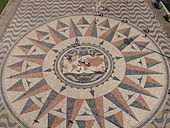 The Compass rose and Mappa mundi, a gift from the Republic of South Africa and created from various marbles
The Compass rose and Mappa mundi, a gift from the Republic of South Africa and created from various marbles
The structure is located on the northern bank of the Tagus River, limited by the Belém Marina, Algés and Dafundo Nautical Centre and the Museum of Popular Art (Portuguese: Museum de Arte Popular), and demarcated by stone pedestals with armillary spheres.[1] Opposite the large square, and across the Avenida de Índia-Avenida de Brasília motorway, is the Praça do Império which fronts the Jerónimos Monastery, Belém Cultural Center and the green-spaces of the Jardim Vasca do Gama.
The original structure, which Telmo, Barros and Almeida created, was erected in steel and cement, while the 33 statutes was produced in a composite of plaster and tow. Ostensibly a 52 m-high slab standing vertically along the bank of the Tagus, the design takes the form of the prow of a caravel (ship used in the early Portuguese exploration). On either side of the slab are ramps that join at the river's edge, with the figure of Henry the Navigator on its edge. On either side of the Infante, along the ramp, are 16 figures (33 in total) representing figures from the Portuguese Age of Discovery. These great people of the era included monarchs, explorers, cartographers, artists, scientists and missionaries. Each idealized figure is designed to show movement towards the front (the unknown sea), projecting a direct or indirect synthesis of their participation in the events after Henry.
The South African government was responsible for gifting the construction of the square in front of the monument: the 50 metre diameter Rosa-dos-Ventos (compass rose), was executed using different types of marble.[1][3] Designed by the architect Cristino da Silva, it includes a Mappa mundi that 14 metres wide, showing the routes of Portuguesecarracks and caravels during the Age of Discovery.[1][3]
The northern façade flanking the staircase are two inscriptions in metal: on the left, "AO INFANTE D. HENRIQVE E AOS PORTVGVESES QVE DESCOBRIRAM OS CAMINHOS DO MAR" (To Prince Henry and the Portuguese that Discovered the Roads of the Sea) over a metal anchor; and, on the right, the words "NO V CENTENÁRIO DO INFANTE D. HENRIQVE 1460 - 1960" (On the Fifth centennary of Prince Henry 1460-1960), over a crown of laurel.[1] The double staircase ascends one level, before the entranceway to the monument, allowing a perspective on the square and the lateral figures.[1]
The interior consists of three areas: the auditorium with space for 101 people, a stage of 18 m², with film projection booth; a secondary level with two halls for exhibition; and the last level with four rooms.[1] Normally, the auditorium hosts a multimedia exhibition on the history of Lisbon, while the other rooms are used for exhibitions. The top of the monument (reached via an elevator or stairs) offers views of the Tagus river, the Belém neighbourhood and its many attractions, including the Belém Tower and the Jerónimos Monastery, which date from the Age of Discovery.
Statues
In addition to the main statute of Henry the Navigator, holding a model of a carrack, on either side of the ramps of the monument are a total of 33 figures from the history of the Discoveries, specifically (from right to left)[3]:
Western profile (figures labeled)Eastern profile (figures labeled)- Western profile
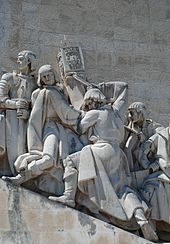 Detail showing Estêvão da Gama (far left) and António Abreu (far right), Bartolomeu Dias (centre left) and Diogo Cão (centre right) raise a padrão/marker
Detail showing Estêvão da Gama (far left) and António Abreu (far right), Bartolomeu Dias (centre left) and Diogo Cão (centre right) raise a padrão/marker
- Afonso V of Portugal
- Vasco da Gama (discoverer of the sea route to India)
- Afonso Gonçalves Baldaia (navigator)
- Pedro Álvares Cabral (discoverer of Brazil)
- Ferdinand Magellan (first to circumnavigate the globe)
- Nicolau Coelho (navigator)
- Gaspar Corte-Real (navigator)
- Martim Afonso de Sousa (navigator)
- João de Barros (writer)
- Estêvão da Gama (sea captain)
- Bartolomeu Dias (first to cross over the Cape of Good Hope)
- Diogo Cão (first to arrive to the Congo river)
- António Abreu (navigator)
- Afonso de Albuquerque (second viceroy of Portuguese India)
- Saint Francis Xavier (missionary)
- Cristóvão da Gama (captain)
- Eastern profile
 Detail showing Pedro Nunes holding an armillary sphere (center). To his left, Jácome de Maiorca and Pedro Escobar; to his right, Pêro de Alenquer, Gil Eanes and João Gonçalves Zarco
Detail showing Pedro Nunes holding an armillary sphere (center). To his left, Jácome de Maiorca and Pedro Escobar; to his right, Pêro de Alenquer, Gil Eanes and João Gonçalves Zarco
- Infante Peter, Duke of Coimbra (son of King John I of Portugal)
- Queen Philippa of Lancaster
- Fernão Mendes Pinto (explorer and writer)
- Friar Gonçalo de Carvalho
- Friar Henrique Carvalho
- Luís de Camões (renaissance poet who celebrated the navigations in the epic Lusiads)
- Nuno Gonçalves (painter)
- Gomes Eanes de Zurara (chronicler)
- Pêro da Covilhã (traveller)
- Jácome de Maiorca (cosmographer)
- Pedro Escobar (navigator)
- Pedro Nunes (mathematician)
- Pêro de Alenquer (navigator)
- Gil Eanes (navigator)
- João Gonçalves Zarco (navigator)
- Infante Fernando, the Saint Prince (son of King John I of Portugal)
In Popular Culture
- The monument was featured in Lisa Stansfield's music video for the single "Change," where she is seen walking up and down the eastern ledge.[4]
References
- Notes
- ^ a b c d e f g h i j k l m n o p q Bandeira, Filomena (2008). "Padrão dos Descobrimentos". In Figueiredo, Paula (in Portuguese). Lisbon, Portugal: SIPA – Sistema de Informação para o Património Arquitectónico. http://www.monumentos.pt/Site/APP_PagesUser/SIPA.aspx?id=9750.
- ^ This renewal project was actually forgot after the death of the minister.
- ^ a b c d Gestão de Equipamentos e Animação Cultural, E.E.M, ed (2011). "Monument to the Discoveries". EGEAC. http://www.padraodosdescobrimentos.egeac.pt/images/stories/folhetos/folhetos_padrao_english.pdf. Retrieved 29 June 2011.
- ^ http://www.gboyle.co.uk/LISA%20qt.HTM
- Sources
- Hancock, Matthew (2003), The Rough Guide to Lisbon, London, England: Rough Guides Ltd, ISBN 1-85-828906-8
- Weimer, Alois; Weimer-Langer, Britta (2000), Portugal, Basingstoke, England: GeoCenter International Ltd., ISBN 3-82-976110-4
- Telmo, Cottinelli (16 September 1934), "O que costumam ser e o que podiam ser os monumentos comemorativos" (in Portuguese), O Diabo, Lisbon, Portugal
- Telmo, Cottinelli (1948), "Renovação da fisionomia da cidade" (in Portuguese), Primeira Reunião Olisiponense, 2, Lisbon, Portugal
- Ministério das Obras Públicas (1959), MOP, ed. (in Portuguese), Relatório da Actividade do Ministério nos anos de 1957 e 1958, 1, Lisbon, Portugal
- (in Portuguese) O Padrão dos Descobrimentos, Lisbon, Portugal: C.A.P.O.P.I., 1960
- (in Portuguese) Os Anos 40 na Arte Portuguesa, Lisbon, Portugal: Fundação Calouste Gulbenkian, 1982
- Synek, Manuela O. (1985), "O Padrão dos Descobrimentos - a gesta portuguesa rasgando o mar" (in Portuguese), Lisboa - Revista Municipal, Lisbon, Portugal, pp. 41–56
- Campos, Isabel (1994) (in Portuguese), O Padrão dos Descobrimentos - roteiro para visita de estudo, Coimbra, Portugal
- Synek, Manuela O. (1994), "Padrão dos Descobrimentos" (in Portuguese), Dicionário da História de Lisboa, Lisbon, Portugal
- Martins, João Paulo do Rosário (1995) (in Portuguese), Cottinelli Telmo (1897-1948) - A Obra do Arquitecto. Dissertação de Mestrado em História da Arte, University Nova de Lisboalocation=Lisbon, Portugal
See also
Categories:- Monuments and memorials in Portugal
- Buildings and structures in Lisbon
- Portuguese New State architecture
- 1940 works
Wikimedia Foundation. 2010.

